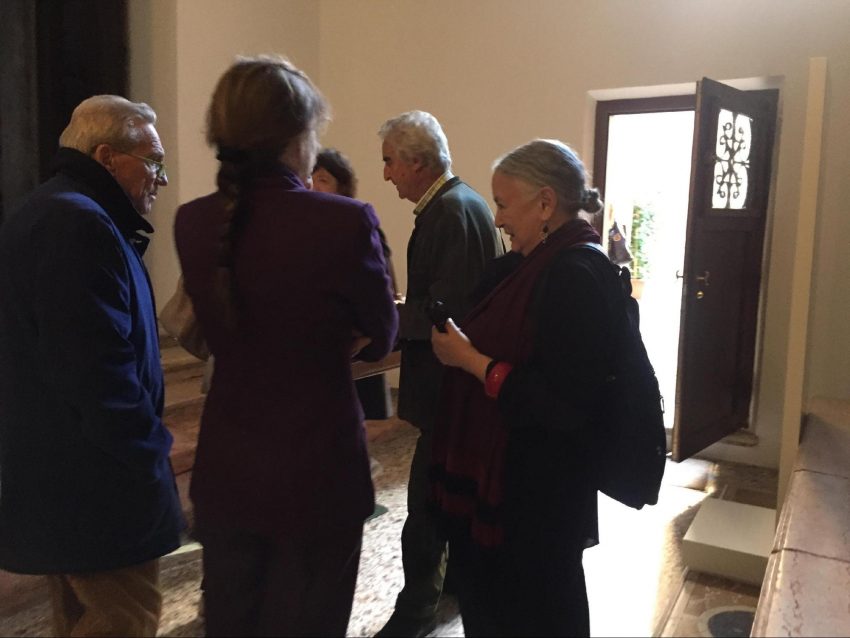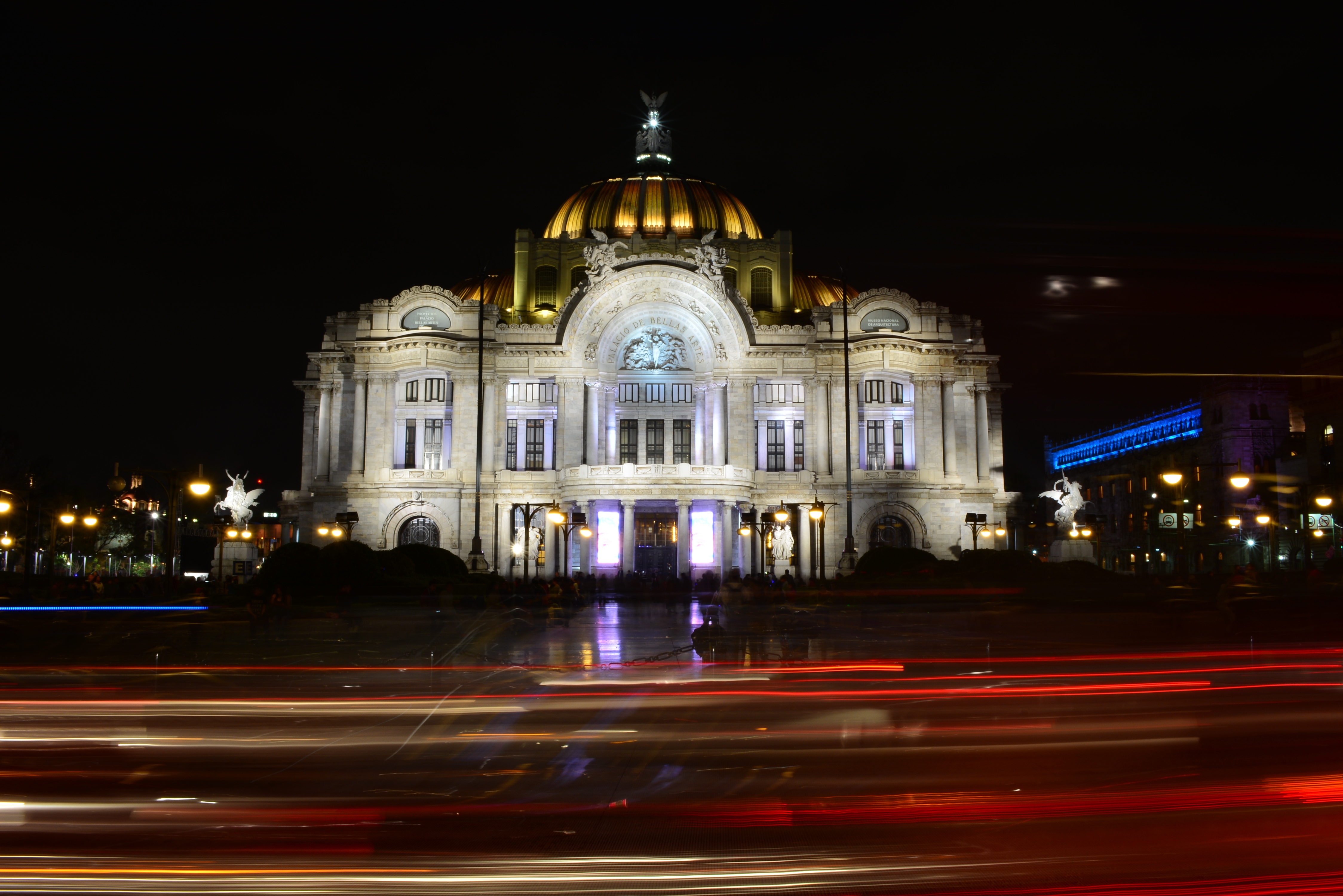My Biennale journey begins at the beautiful Santa Lucia train station in Venice, after having visited the 24th “Of Art“ fair in Milan. Excitement was in the air, with passengers eagerly greeting each other and planning their adventurous nights ahead.
After a restful first night at Isola San Giorgio, I set off by visiting the spectacular retrospective of Michelangelo Pistoletto. Guided by his wife Maria, I could not help but be in awe of his first “Specchi“ from 1961.
In the photo: Maria, the wife of Pistoletto guiding us around the exhibition “One and One makes Three”, Abbazia San Giorgio Maggiore. ( Biennale di Venezia 2017) – Photo Credit: Oliva Sartogo
“When in 1961 Michelangelo began to paint his face on a background varnished to the point that it reflected, he could not help but be astonished to see it coming towards him: the reflection appeared to be as real as the surface it was painted on.“ – Maria Pistoletto
In the photo: Work: Silver Portrait, 1960 (acrylic, oil and silver on board 200x200cm, courtesy of Citta dell’Arte-Fondazione Pistoletto Biella) (Biennale di Venezia 2017)
Placed in front of the choir at the center of the San Giorgio church, was Pistoletto’s “Love Indifference, 1975-2017” an installation reflecting the viewers in each mirror and unifying them.
In the Photo: Michelangelo Pistoletto, Suspended Perimeter–Love Indifference, 1975–2017 Photo Credit: Oliva Sartogo
Next, I moved to the exhibition of Alighiero Boetti located at the Fondazione Cini, also on the San Giorgio Island.
The exhibition titled “Minimum and Maximum“ was curated by Boetti’s daughter Agata, in dialogue with Luca Massimo Barbero and Hans Ulrich Obrist. It shows the most important works by Boetti, from his “Maps“ to the “Tutto“.
Luckily enough we bumped into Agata, who explained the last room to us: Boetti’s relation with his Rank Xerox copier. The room is covered by photocopies done in 1984. Boetti copied any image or text he found inspiring, 1665 in total, and from the copies later created red books to keep as an archive. Agata explained his process and then showed us Alighiero’s performance with his photocopier when he made a self-portrait by fingerspelling his name. Encouraged by site-specific Mexican artist Mario Garcia Torres, we did our own Boetti performance with a photocopier and red sheets of paper.
For me, the two retrospectives were perhaps the most powerful moments at the Biennale. Boetti and Pistoletto encouraged a creative and unexpectedly playful attitude.
While creating “La Venere degli Stracci” and photocopying their face, their minds were thinking outside the box.
While the Trans-avantguardian artists were representing the moment with their brush strokes, Alighiero and Michelangelo were being creative with unconventional materials.
I could not share the same excitement for most other pavilions. However, I did have strong feelings on the German pavilion (artist Anne Imhof), the Australian pavilion (artist Tracey Moffatt), and the Lebanese pavilion (artist Zad Moultaka). They all expressed powerful messages and left me in deep thought after each visit.
In the photo: Entrance of the German Pavilion, two German-Dobermanns barking and playing on the terrace of the pavilion. (Biennale di Venezia 2017) Photo Credit: Oliva Sartogo
Anne Imhof, managed to show the neo-dramatic German society, while photographer Tracey Moffatt pictured immigrants, linking them to movie scenes and Hollywood stars such as Elizabeth Taylor and Julie Christie.
Moffat manipulated the images by cropping and coloring them, creating resemblances to reduced blobs or movie stills. The artist was on site, welcoming the press and explaining her work, focusing on her relation to the theme of immigrants and the indigenous people of Australia.
In the photo: Singing (live) performance at the German Pavilion. (Biennale di Venezia 2017) Photo Credit: Oliva Sartogo
If the German Pavilion was an on-going performance, the Australian was more cinematographic, and the Lebanese one was definitely musical and architectural.
Viewers entered this dark atmosphere, with a mix of various electronic voices and a golden map at the end of the space at the Arsenal. The map itself was filled with ancient Lebanese coins and resembled ruins of an ancient city.
The official press release of Zad Moultaka states that:
“ŠamaŠ is rooted mentally, physically and philosophically in the refusal of the drama that we are witnessing in this solar region of the world that is the Middle East, cradle of eastern and western civilisations. The Arab apocalypse, which threatens to put an end to these civilisations, is not unavoidable. Under Syria’s bombarded skies, one can still glimpse the emergence of the first codes of Babylonian laws and the desire of a wild peace. Today’s Man has been ripped from the soil and fallen down from the sky. Deaf and blind to the essence of things, he is programming his own obliteration, hastening with it, by anxiety, the crumbling of the world…”
Apart from works by Alicja Kwade, Thu Van Tran, Anri Sala and Ernesto Neto and the Roberto Cuoghi, the main Arsenal Central Pavilion was very much based on female and handcrafted art. It was definitely the first major recognition of the Female artists; the Romanian Pavilion, for example, chose to show Greta Bratescu (born in 1929), who developed since 1960 works around female subjectivity through various modes of conceptualizing feminine mythologies.
In the photo: Greta Bratescu, Autoportret în oglindă / Self-portrait in the mirror, 2001 – Object, mirror, wood, photo collage 21 x 15 cm (Biennale di Venezia 2017) Photo Credit: Oliva Sartogo
For me, the title of this year Biennale did not match with what was on display. The most impressive pavilions all contained live and performed art, giving a sense of “arte viva”.
 In the photo: “Tomorrow is another day” exhibition, Mark Bradford, American Pavilion. (Biennale di Venezia 2017) Photo Credit: Oliva Sartogo
In the photo: “Tomorrow is another day” exhibition, Mark Bradford, American Pavilion. (Biennale di Venezia 2017) Photo Credit: Oliva Sartogo
American artist Mark Bradford transformed his pavilion into his own palco-scenico, using his paintings as frames.
For those visiting, I definitely suggest having a look at:
– White Pae ( Fondazione Cini gardens)
– VAC Foundation “Space Force Construction” (Russian historical 1921 works by Rodchenko and Popova mixed with Barbara Kruger and Wolfgang Tillmans new work)
– GlassStress, Palazzo Franchetti
– Palazzo Fortuny
– Douglas Gordon (video installation inside the “carceri Palazzo Ducale”)




















